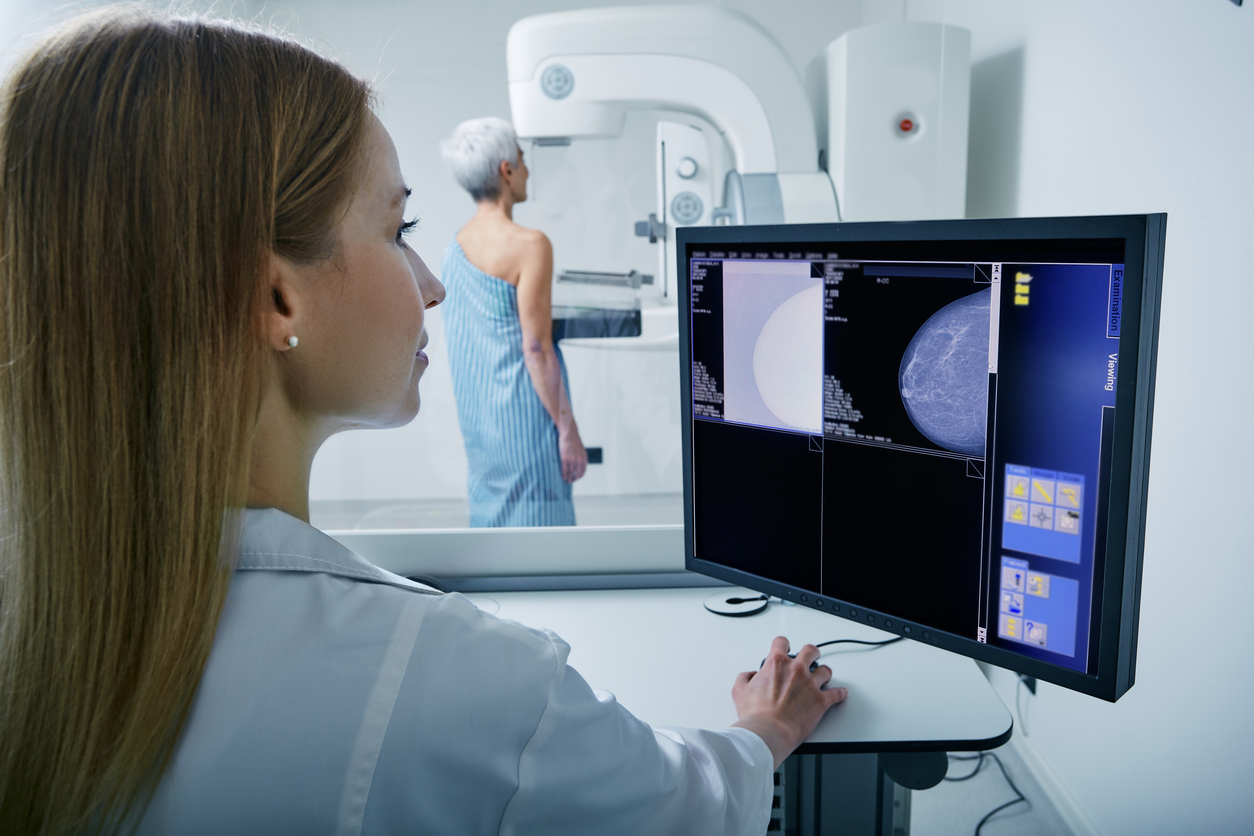2025-10-17
Beyond mammography: new evidence for dense breast screening
Oncology
By Carolina Lima | Published on October 17, 2025 | 3 min read
Breast cancer screening is a cornerstone of early detection, but for women with dense breast tissue, traditional mammography often falls short. To address this challenge, the Breast Screening—Risk Adapted Imaging for Density (BRAID) trial, recently published in The Lancet, offers promising evidence on whether supplemental imaging can bridge this gap.
Breast density is categorized using BI-RADS, with categories C (heterogeneously dense) and D (extremely dense) representing the highest levels. Women in these groups face two issues: a higher likelihood of developing breast cancer and a reduced sensitivity of mammography. This dual risk highlighting the need for alternative screening methods.
The BRAID trial is a large, randomized controlled study conducted across 10 UK National Health Service sites. It enrolled women aged 50 to 70 with dense breasts and a negative mammogram. Participants were randomized to one of four arms:
The primary outcome was the cancer detection rate after the first round of imaging. Secondary outcomes included recall and biopsy rates, as well as tumor characteristics.
Over 8,800 women were randomized:
Detection rates (per 1,000):
This confirms that CEM and MRI more than double the detection rate compared to standard mammography, while ABUS performs worse than standard care. Notably, tumors identified by CEM and MRI were about half the size of those detected by ABUS, strongly suggesting earlier detection.
Adverse events were rare but notable. MRI reported a single case of contrast extravasation, which occurs when the injected contrast agent leaks from the vein into surrounding tissue. CEM reported 24 contrast reactions (mostly minor, with one severe case). ABUS had no reported adverse events, making it the safest modality, though it also had the lowest cancer detection rate.
The results of the BRAID trial underscore a critical shift in breast cancer screening for women with dense breast tissue. Both MRI and CEM demonstrated a substantial improvement in cancer detection compared to ABUS and standard mammography. These findings suggest that supplemental imaging is not just an option but a potential necessity for this high-risk population. However, the adoption of these technologies is not without challenges. Cost, accessibility and resource allocation remain major barriers, particularly for MRI, which is expensive and time intensive. CEM, while more accessible, introduces concerns about contrast-related reactions, though these risks are relatively low.
Another critical consideration is overdiagnosis—the detection of cancers that may never become clinically significant. While early detection is generally advantageous, unnecessary interventions can lead to patient anxiety, overtreatment, and increased healthcare costs. The BRAID trial aims to address these concerns particularly regarding mortality impact and cost-effectiveness.
The implications of these findings are profound. MRI and CEM clearly demonstrate superior detection capabilities, but their integration into routine practice must account for cost, accessibility, and the potential risks associated with contrast use. For now, the message is simple yet powerful: one-size-fits-all screening no longer meets the needs of women with dense breasts. Supplemental imaging—especially MRI and CEM—offers a real opportunity for earlier detection and better outcomes.
The next step is ensuring that these advances are accessible, safe, and tailored to each woman’s unique risk. Because at the heart of this conversation is a simple truth: every woman deserves the best chance at early detection, and that means moving toward truly personalized screening.
About the Author – Carolina Lima
Carolina is a specialist in Anaesthesiology with a deep passion for learning and sharing medical knowledge. Dedicated to advancing the field, Dr. Lima strives to bring fresh, evidence-based insights to the medical community. Viewing medicine not merely as a profession but as a lifelong journey of continuous learning, Dr. Lima is committed to making complex information clear, practical, and useful for healthcare professionals around the world.
Breast cancer screening is a cornerstone of early detection, but for women with dense breast tissue, traditional mammography often falls short. To address this challenge, the Breast Screening—Risk Adapted Imaging for Density (BRAID) trial, recently published in The Lancet, offers promising evidence on whether supplemental imaging can bridge this gap.
Dense breasts: key facts
Breast density is categorized using BI-RADS, with categories C (heterogeneously dense) and D (extremely dense) representing the highest levels. Women in these groups face two issues: a higher likelihood of developing breast cancer and a reduced sensitivity of mammography. This dual risk highlighting the need for alternative screening methods.
The BRAID study
The BRAID trial is a large, randomized controlled study conducted across 10 UK National Health Service sites. It enrolled women aged 50 to 70 with dense breasts and a negative mammogram. Participants were randomized to one of four arms:
- Standard care: Full-field digital mammography only
- Supplemental imaging:
- Abbreviated MRI
- Automated Whole-Breast Ultrasound (ABUS)
- Contrast-Enhanced Mammography (CEM)
The primary outcome was the cancer detection rate after the first round of imaging. Secondary outcomes included recall and biopsy rates, as well as tumor characteristics.
Over 8,800 women were randomized:
- Standard care: 2,568
- MRI: 2,130
- ABUS: 2,141
- CEM: 2,035
Detection rates (per 1,000):
- CEM: 19.2
- MRI: 17.4
- Standard care: 8.4
- ABUS: 4.2
This confirms that CEM and MRI more than double the detection rate compared to standard mammography, while ABUS performs worse than standard care. Notably, tumors identified by CEM and MRI were about half the size of those detected by ABUS, strongly suggesting earlier detection.
Safety and adverse events
Adverse events were rare but notable. MRI reported a single case of contrast extravasation, which occurs when the injected contrast agent leaks from the vein into surrounding tissue. CEM reported 24 contrast reactions (mostly minor, with one severe case). ABUS had no reported adverse events, making it the safest modality, though it also had the lowest cancer detection rate.
Clinical implications
The results of the BRAID trial underscore a critical shift in breast cancer screening for women with dense breast tissue. Both MRI and CEM demonstrated a substantial improvement in cancer detection compared to ABUS and standard mammography. These findings suggest that supplemental imaging is not just an option but a potential necessity for this high-risk population. However, the adoption of these technologies is not without challenges. Cost, accessibility and resource allocation remain major barriers, particularly for MRI, which is expensive and time intensive. CEM, while more accessible, introduces concerns about contrast-related reactions, though these risks are relatively low.
Another critical consideration is overdiagnosis—the detection of cancers that may never become clinically significant. While early detection is generally advantageous, unnecessary interventions can lead to patient anxiety, overtreatment, and increased healthcare costs. The BRAID trial aims to address these concerns particularly regarding mortality impact and cost-effectiveness.
What’s next?
The implications of these findings are profound. MRI and CEM clearly demonstrate superior detection capabilities, but their integration into routine practice must account for cost, accessibility, and the potential risks associated with contrast use. For now, the message is simple yet powerful: one-size-fits-all screening no longer meets the needs of women with dense breasts. Supplemental imaging—especially MRI and CEM—offers a real opportunity for earlier detection and better outcomes.
The next step is ensuring that these advances are accessible, safe, and tailored to each woman’s unique risk. Because at the heart of this conversation is a simple truth: every woman deserves the best chance at early detection, and that means moving toward truly personalized screening.
Read next: A heterogeneous cancer, evolving management
About the Author – Carolina Lima
Anaesthesiology specialist
Carolina is a specialist in Anaesthesiology with a deep passion for learning and sharing medical knowledge. Dedicated to advancing the field, Dr. Lima strives to bring fresh, evidence-based insights to the medical community. Viewing medicine not merely as a profession but as a lifelong journey of continuous learning, Dr. Lima is committed to making complex information clear, practical, and useful for healthcare professionals around the world.

Last press reviews
Could cinnamon become a natural treatment for metabolic syndrome?

By Lila Rouland | Published on December 5, 2025 | 3 min read<br><br>...
Who is afraid of Christmas? Do holidays trigger psychiatric crises?

By Carolina Lima | Published on Décember 4, 2025 | 3 min read
Twice-yearly injections to change the game?

By Ana Espino | Published on December 3rd, 2025 | 3 min read